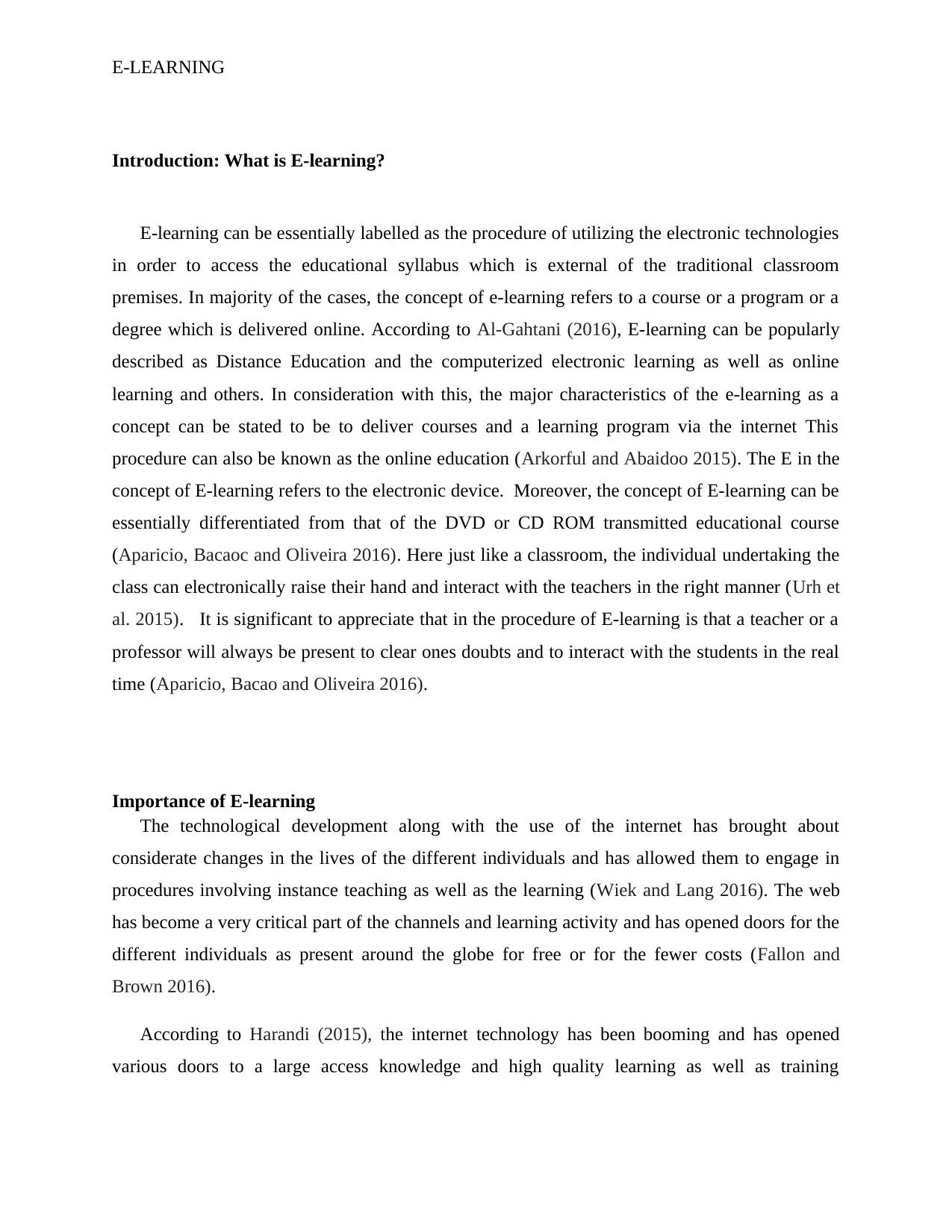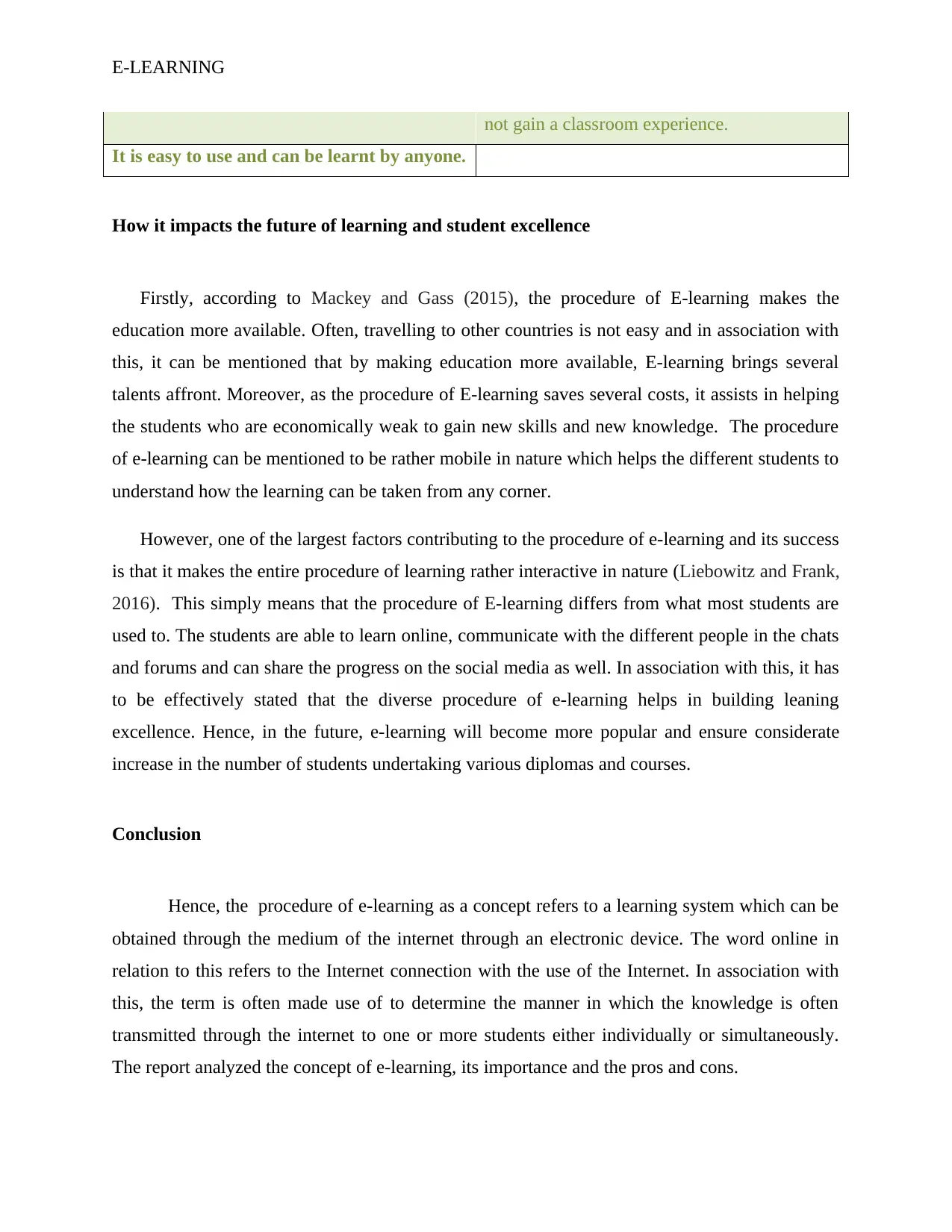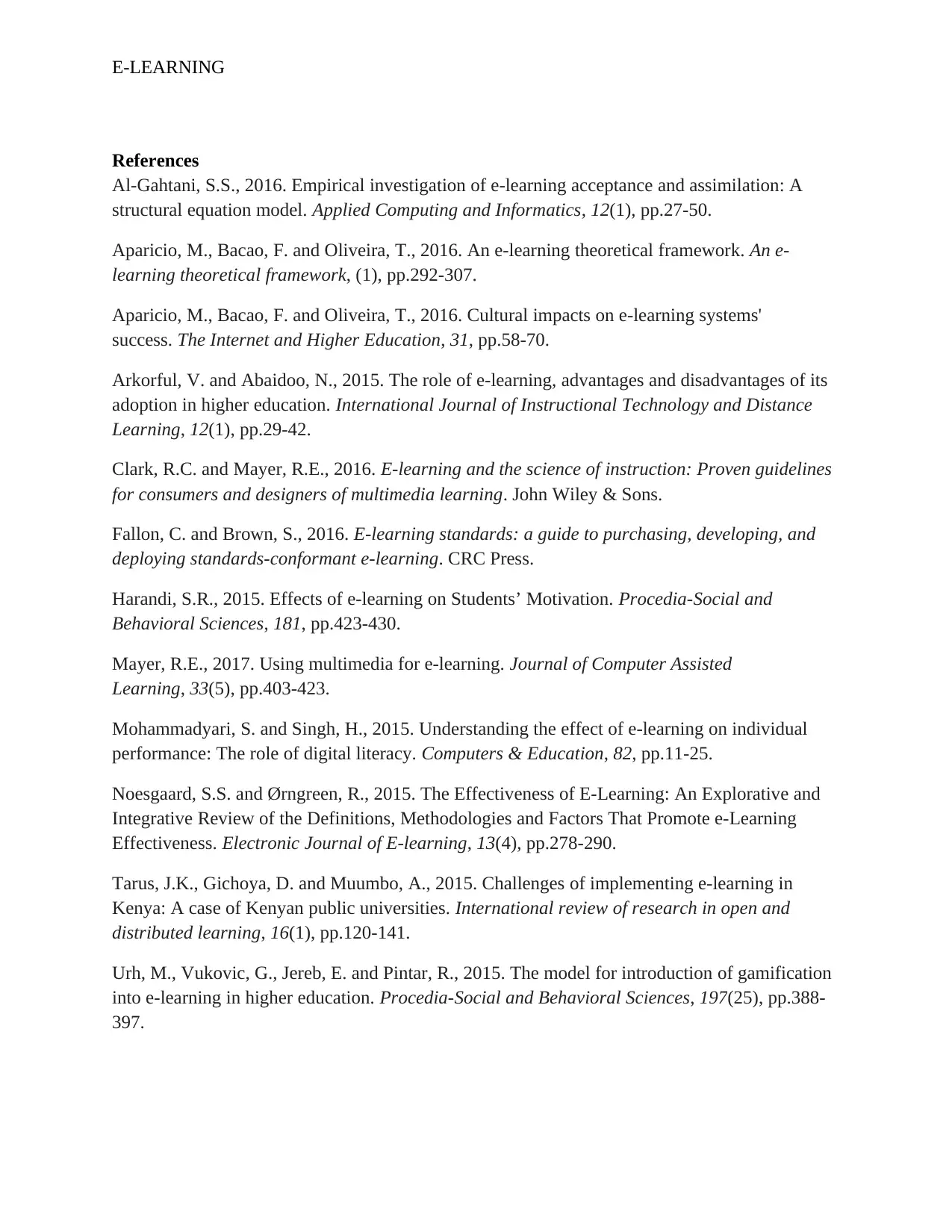E-Learning Report: Analyzing Pros, Cons, and Future of Education
VerifiedAdded on 2022/08/18
|7
|1596
|16
Report
AI Summary
This report delves into the concept of e-learning, defining it as the utilization of electronic technologies to access educational content outside traditional classrooms. It highlights the importance of e-learning, driven by technological advancements and internet accessibility, which allows for global access to knowledge and skills development at reduced costs. The report presents a table comparing the pros and cons of e-learning, such as accessibility and cost-effectiveness versus potential technological issues and lack of classroom experience. Furthermore, it discusses the impact of e-learning on the future of learning and student excellence, emphasizing its role in making education more available, cost-effective, and interactive. The report concludes by reiterating the definition of e-learning and summarizing its key aspects, including its importance and the advantages and disadvantages associated with its implementation.

Running head: E-LEARNING
E-LEARNING
Name of the Student
Name of the University
Author Note
E-LEARNING
Name of the Student
Name of the University
Author Note
Paraphrase This Document
Need a fresh take? Get an instant paraphrase of this document with our AI Paraphraser

E-LEARNING
Table of Contents
Introduction: What is E-learning?...................................................................................................2
Importance of E-learning.................................................................................................................2
Pros and cons of E-learning.............................................................................................................3
How it impacts the future of learning and student excellence.........................................................4
Conclusion.......................................................................................................................................4
References........................................................................................................................................5
Table of Contents
Introduction: What is E-learning?...................................................................................................2
Importance of E-learning.................................................................................................................2
Pros and cons of E-learning.............................................................................................................3
How it impacts the future of learning and student excellence.........................................................4
Conclusion.......................................................................................................................................4
References........................................................................................................................................5

E-LEARNING
Introduction: What is E-learning?
E-learning can be essentially labelled as the procedure of utilizing the electronic technologies
in order to access the educational syllabus which is external of the traditional classroom
premises. In majority of the cases, the concept of e-learning refers to a course or a program or a
degree which is delivered online. According to Al-Gahtani (2016), E-learning can be popularly
described as Distance Education and the computerized electronic learning as well as online
learning and others. In consideration with this, the major characteristics of the e-learning as a
concept can be stated to be to deliver courses and a learning program via the internet This
procedure can also be known as the online education (Arkorful and Abaidoo 2015). The E in the
concept of E-learning refers to the electronic device. Moreover, the concept of E-learning can be
essentially differentiated from that of the DVD or CD ROM transmitted educational course
(Aparicio, Bacaoc and Oliveira 2016). Here just like a classroom, the individual undertaking the
class can electronically raise their hand and interact with the teachers in the right manner (Urh et
al. 2015). It is significant to appreciate that in the procedure of E-learning is that a teacher or a
professor will always be present to clear ones doubts and to interact with the students in the real
time (Aparicio, Bacao and Oliveira 2016).
Importance of E-learning
The technological development along with the use of the internet has brought about
considerate changes in the lives of the different individuals and has allowed them to engage in
procedures involving instance teaching as well as the learning (Wiek and Lang 2016). The web
has become a very critical part of the channels and learning activity and has opened doors for the
different individuals as present around the globe for free or for the fewer costs (Fallon and
Brown 2016).
According to Harandi (2015), the internet technology has been booming and has opened
various doors to a large access knowledge and high quality learning as well as training
Introduction: What is E-learning?
E-learning can be essentially labelled as the procedure of utilizing the electronic technologies
in order to access the educational syllabus which is external of the traditional classroom
premises. In majority of the cases, the concept of e-learning refers to a course or a program or a
degree which is delivered online. According to Al-Gahtani (2016), E-learning can be popularly
described as Distance Education and the computerized electronic learning as well as online
learning and others. In consideration with this, the major characteristics of the e-learning as a
concept can be stated to be to deliver courses and a learning program via the internet This
procedure can also be known as the online education (Arkorful and Abaidoo 2015). The E in the
concept of E-learning refers to the electronic device. Moreover, the concept of E-learning can be
essentially differentiated from that of the DVD or CD ROM transmitted educational course
(Aparicio, Bacaoc and Oliveira 2016). Here just like a classroom, the individual undertaking the
class can electronically raise their hand and interact with the teachers in the right manner (Urh et
al. 2015). It is significant to appreciate that in the procedure of E-learning is that a teacher or a
professor will always be present to clear ones doubts and to interact with the students in the real
time (Aparicio, Bacao and Oliveira 2016).
Importance of E-learning
The technological development along with the use of the internet has brought about
considerate changes in the lives of the different individuals and has allowed them to engage in
procedures involving instance teaching as well as the learning (Wiek and Lang 2016). The web
has become a very critical part of the channels and learning activity and has opened doors for the
different individuals as present around the globe for free or for the fewer costs (Fallon and
Brown 2016).
According to Harandi (2015), the internet technology has been booming and has opened
various doors to a large access knowledge and high quality learning as well as training
⊘ This is a preview!⊘
Do you want full access?
Subscribe today to unlock all pages.

Trusted by 1+ million students worldwide

E-LEARNING
procedure. Hence, this easy access or considerate use of information helps the people to upgrade
their skills at a considerably lower as well as the fewer costs.
In order to facilitate this study further, the different researchers also made use of another
study and evaluated the student`s leaning satisfaction as well as the effectiveness in the e-
learning landscape and it was found that the satisfaction level with the web enhanced technology
increased to 95% using the e-learning as compared to physical e-learning procedure (Noesgaard
and Ørngreen 2015). The results of the study were published in the Journal of e-learning and
Higher education. Mayer (2017) states that the web based learning procedure as a method of
learning can be understood to be largely suitable for the different teachers and instructors as well.
Hence, following this, it can be critically observed that the e-learning as a procedure has
become considerately popular and in line with this, the enhancement of the learning procedure
has made the online courses more popular and necessary for the adequate spread of the
knowledge procedure (Mohammadyari and Singh 2015). Hence, any teacher present in the
institute needs to see to it that they are being able to effectively use the E-learning technology
and help the students in gaining adequate skills with the help of which the advantages of the e-
learning can be experienced accordingly (Clark and Mayer 2016).At present e-learning is not
only adopted by the students but by several enterprises as well (Tarus, Gichoya and Muumbo
2015).
Pros and cons of E-learning
In order to understand the manner in which the e-learning is beneficial as well as has
shortcomings, the following table can be referred to:
Pros of e-learning Cons of e-learning
It is easily accessible and can be viewed by a
million students from home or any location.
There might be various technological issues
which may bar everyone and affect their
learning
It costs less as compared to the main stream
education.
Lack of control over the topic understanding
and student discipline.
It is tailored as per the needs of the students. The students have to study in isolation and will
procedure. Hence, this easy access or considerate use of information helps the people to upgrade
their skills at a considerably lower as well as the fewer costs.
In order to facilitate this study further, the different researchers also made use of another
study and evaluated the student`s leaning satisfaction as well as the effectiveness in the e-
learning landscape and it was found that the satisfaction level with the web enhanced technology
increased to 95% using the e-learning as compared to physical e-learning procedure (Noesgaard
and Ørngreen 2015). The results of the study were published in the Journal of e-learning and
Higher education. Mayer (2017) states that the web based learning procedure as a method of
learning can be understood to be largely suitable for the different teachers and instructors as well.
Hence, following this, it can be critically observed that the e-learning as a procedure has
become considerately popular and in line with this, the enhancement of the learning procedure
has made the online courses more popular and necessary for the adequate spread of the
knowledge procedure (Mohammadyari and Singh 2015). Hence, any teacher present in the
institute needs to see to it that they are being able to effectively use the E-learning technology
and help the students in gaining adequate skills with the help of which the advantages of the e-
learning can be experienced accordingly (Clark and Mayer 2016).At present e-learning is not
only adopted by the students but by several enterprises as well (Tarus, Gichoya and Muumbo
2015).
Pros and cons of E-learning
In order to understand the manner in which the e-learning is beneficial as well as has
shortcomings, the following table can be referred to:
Pros of e-learning Cons of e-learning
It is easily accessible and can be viewed by a
million students from home or any location.
There might be various technological issues
which may bar everyone and affect their
learning
It costs less as compared to the main stream
education.
Lack of control over the topic understanding
and student discipline.
It is tailored as per the needs of the students. The students have to study in isolation and will
Paraphrase This Document
Need a fresh take? Get an instant paraphrase of this document with our AI Paraphraser

E-LEARNING
not gain a classroom experience.
It is easy to use and can be learnt by anyone.
How it impacts the future of learning and student excellence
Firstly, according to Mackey and Gass (2015), the procedure of E-learning makes the
education more available. Often, travelling to other countries is not easy and in association with
this, it can be mentioned that by making education more available, E-learning brings several
talents affront. Moreover, as the procedure of E-learning saves several costs, it assists in helping
the students who are economically weak to gain new skills and new knowledge. The procedure
of e-learning can be mentioned to be rather mobile in nature which helps the different students to
understand how the learning can be taken from any corner.
However, one of the largest factors contributing to the procedure of e-learning and its success
is that it makes the entire procedure of learning rather interactive in nature (Liebowitz and Frank,
2016). This simply means that the procedure of E-learning differs from what most students are
used to. The students are able to learn online, communicate with the different people in the chats
and forums and can share the progress on the social media as well. In association with this, it has
to be effectively stated that the diverse procedure of e-learning helps in building leaning
excellence. Hence, in the future, e-learning will become more popular and ensure considerate
increase in the number of students undertaking various diplomas and courses.
Conclusion
Hence, the procedure of e-learning as a concept refers to a learning system which can be
obtained through the medium of the internet through an electronic device. The word online in
relation to this refers to the Internet connection with the use of the Internet. In association with
this, the term is often made use of to determine the manner in which the knowledge is often
transmitted through the internet to one or more students either individually or simultaneously.
The report analyzed the concept of e-learning, its importance and the pros and cons.
not gain a classroom experience.
It is easy to use and can be learnt by anyone.
How it impacts the future of learning and student excellence
Firstly, according to Mackey and Gass (2015), the procedure of E-learning makes the
education more available. Often, travelling to other countries is not easy and in association with
this, it can be mentioned that by making education more available, E-learning brings several
talents affront. Moreover, as the procedure of E-learning saves several costs, it assists in helping
the students who are economically weak to gain new skills and new knowledge. The procedure
of e-learning can be mentioned to be rather mobile in nature which helps the different students to
understand how the learning can be taken from any corner.
However, one of the largest factors contributing to the procedure of e-learning and its success
is that it makes the entire procedure of learning rather interactive in nature (Liebowitz and Frank,
2016). This simply means that the procedure of E-learning differs from what most students are
used to. The students are able to learn online, communicate with the different people in the chats
and forums and can share the progress on the social media as well. In association with this, it has
to be effectively stated that the diverse procedure of e-learning helps in building leaning
excellence. Hence, in the future, e-learning will become more popular and ensure considerate
increase in the number of students undertaking various diplomas and courses.
Conclusion
Hence, the procedure of e-learning as a concept refers to a learning system which can be
obtained through the medium of the internet through an electronic device. The word online in
relation to this refers to the Internet connection with the use of the Internet. In association with
this, the term is often made use of to determine the manner in which the knowledge is often
transmitted through the internet to one or more students either individually or simultaneously.
The report analyzed the concept of e-learning, its importance and the pros and cons.

E-LEARNING
⊘ This is a preview!⊘
Do you want full access?
Subscribe today to unlock all pages.

Trusted by 1+ million students worldwide

E-LEARNING
References
Al-Gahtani, S.S., 2016. Empirical investigation of e-learning acceptance and assimilation: A
structural equation model. Applied Computing and Informatics, 12(1), pp.27-50.
Aparicio, M., Bacao, F. and Oliveira, T., 2016. An e-learning theoretical framework. An e-
learning theoretical framework, (1), pp.292-307.
Aparicio, M., Bacao, F. and Oliveira, T., 2016. Cultural impacts on e-learning systems'
success. The Internet and Higher Education, 31, pp.58-70.
Arkorful, V. and Abaidoo, N., 2015. The role of e-learning, advantages and disadvantages of its
adoption in higher education. International Journal of Instructional Technology and Distance
Learning, 12(1), pp.29-42.
Clark, R.C. and Mayer, R.E., 2016. E-learning and the science of instruction: Proven guidelines
for consumers and designers of multimedia learning. John Wiley & Sons.
Fallon, C. and Brown, S., 2016. E-learning standards: a guide to purchasing, developing, and
deploying standards-conformant e-learning. CRC Press.
Harandi, S.R., 2015. Effects of e-learning on Students’ Motivation. Procedia-Social and
Behavioral Sciences, 181, pp.423-430.
Mayer, R.E., 2017. Using multimedia for e‐learning. Journal of Computer Assisted
Learning, 33(5), pp.403-423.
Mohammadyari, S. and Singh, H., 2015. Understanding the effect of e-learning on individual
performance: The role of digital literacy. Computers & Education, 82, pp.11-25.
Noesgaard, S.S. and Ørngreen, R., 2015. The Effectiveness of E-Learning: An Explorative and
Integrative Review of the Definitions, Methodologies and Factors That Promote e-Learning
Effectiveness. Electronic Journal of E-learning, 13(4), pp.278-290.
Tarus, J.K., Gichoya, D. and Muumbo, A., 2015. Challenges of implementing e-learning in
Kenya: A case of Kenyan public universities. International review of research in open and
distributed learning, 16(1), pp.120-141.
Urh, M., Vukovic, G., Jereb, E. and Pintar, R., 2015. The model for introduction of gamification
into e-learning in higher education. Procedia-Social and Behavioral Sciences, 197(25), pp.388-
397.
References
Al-Gahtani, S.S., 2016. Empirical investigation of e-learning acceptance and assimilation: A
structural equation model. Applied Computing and Informatics, 12(1), pp.27-50.
Aparicio, M., Bacao, F. and Oliveira, T., 2016. An e-learning theoretical framework. An e-
learning theoretical framework, (1), pp.292-307.
Aparicio, M., Bacao, F. and Oliveira, T., 2016. Cultural impacts on e-learning systems'
success. The Internet and Higher Education, 31, pp.58-70.
Arkorful, V. and Abaidoo, N., 2015. The role of e-learning, advantages and disadvantages of its
adoption in higher education. International Journal of Instructional Technology and Distance
Learning, 12(1), pp.29-42.
Clark, R.C. and Mayer, R.E., 2016. E-learning and the science of instruction: Proven guidelines
for consumers and designers of multimedia learning. John Wiley & Sons.
Fallon, C. and Brown, S., 2016. E-learning standards: a guide to purchasing, developing, and
deploying standards-conformant e-learning. CRC Press.
Harandi, S.R., 2015. Effects of e-learning on Students’ Motivation. Procedia-Social and
Behavioral Sciences, 181, pp.423-430.
Mayer, R.E., 2017. Using multimedia for e‐learning. Journal of Computer Assisted
Learning, 33(5), pp.403-423.
Mohammadyari, S. and Singh, H., 2015. Understanding the effect of e-learning on individual
performance: The role of digital literacy. Computers & Education, 82, pp.11-25.
Noesgaard, S.S. and Ørngreen, R., 2015. The Effectiveness of E-Learning: An Explorative and
Integrative Review of the Definitions, Methodologies and Factors That Promote e-Learning
Effectiveness. Electronic Journal of E-learning, 13(4), pp.278-290.
Tarus, J.K., Gichoya, D. and Muumbo, A., 2015. Challenges of implementing e-learning in
Kenya: A case of Kenyan public universities. International review of research in open and
distributed learning, 16(1), pp.120-141.
Urh, M., Vukovic, G., Jereb, E. and Pintar, R., 2015. The model for introduction of gamification
into e-learning in higher education. Procedia-Social and Behavioral Sciences, 197(25), pp.388-
397.
1 out of 7
Related Documents
Your All-in-One AI-Powered Toolkit for Academic Success.
+13062052269
info@desklib.com
Available 24*7 on WhatsApp / Email
![[object Object]](/_next/static/media/star-bottom.7253800d.svg)
Unlock your academic potential
Copyright © 2020–2025 A2Z Services. All Rights Reserved. Developed and managed by ZUCOL.





